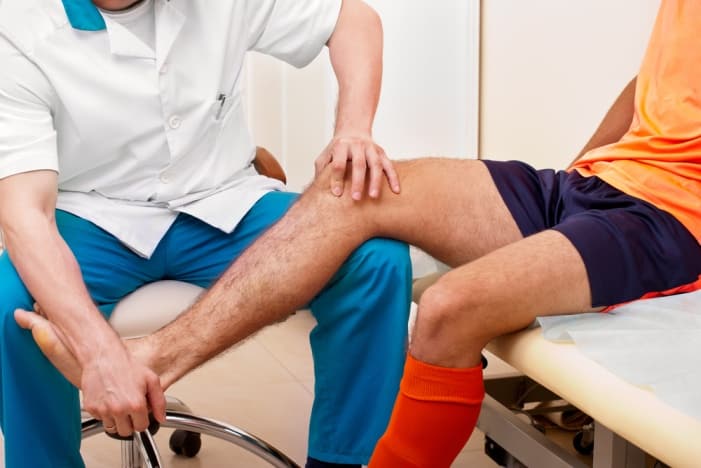How To Sleep With Knee Pain
At Graceville Physio, we get it. Trying to sleep with knee pain, or any type of pain for that matter, isn’t as easy as closing your eyes and waiting a few minutes before eventually dozing off. Even worse is that not getting enough rest worsens the pain you feel in the morning.
The good news, however, is that there are things you can do right now that will not only help relieve severe knee pain at night but also help you catch some ZZZs. Check them out below.
1. Change your sleeping position
Different sleeping positions have different high pressure points. Specifically for your knees, the front and sides are under more pressure when sleeping on your stomach and side respectively.
Depending on what’s causing it, these positions may make your knee pain worse.
Try sleeping on your back instead. If that just isn’t possible or if you’re uncomfortable with this position, sleeping on your side while using knee pillows is the next best thing.
This brings us to the next tip.
2. Use strategic pillow placements
This tip is applicable for both back and side sleepers. For stomach sleepers, refer back to the previous tip.
Knee pillow benefits for side sleepers:
- It helps improve spinal alignment, and
- It provides a cushion between your knees
The cushion particularly helps when your knee pain is at the medial parts of those joints.
Knee pillow benefits for back sleepers:
- It places your knee in a more relaxed position, and
- It elevates your knees above your heart
This “relaxed” position (i.e. open-packed position) is when your knees are slightly bent to about 25 degrees. This position is where your knees are under the least amount of stress because there isn’t any tension from your ligaments.
The inherent elevation from having a pillow (or a rolled towel) under your knees means that gravity makes it easier for your veins to push blood from your knees back to your heart. This is particularly effective at alleviating nighttime knee pain and inflammation if you recently suffered an injury but it also helps with cases of venous insufficiency.
3. Pick the right mattress
Your mattress is a big determining factor in how aligned your spine and your other joints are during sleep. For this reason, choosing the right mattress is crucial if you want to alleviate sore knees when sleeping – or avoid joint pain altogether.
But, while there certainly are generalities to picking the right mattress, it eventually all comes down to your own preferences and necessities.
To help you out, though, keep these in mind:
- Pick a mattress that’s firm enough to keep your spine aligned with your dominant sleeping position. If you’re a side sleeper, that might mean a softer mattress so your hips and shoulders drop just enough to keep everything else in line. For back sleepers, it might be a firmer mattress so your lower back doesn’t sag.
- Your weight also plays a role. Heavier people will generally require firmer mattresses whereas the opposite is true for kids and petite adults.
- Use appropriately sized pillows to support your joints and spine.
- Memory foam works great if you predominantly sleep in one position whereas a hybrid mattress might be better if you’re a combination sleeper.
4. Fix the cause of your knee pain
This is the most effective way to deal with knee pain regardless of the time of day. Without actually fixing the root cause, quick fixes can only get you so far and the pain you feel will inevitably keep coming back.
Knee osteoarthritis is a common cause of nighttime knee pain but other injuries such as overuse, sprains, bursitis, are frequent as well.
If you’re unsure, visit your doctor to get an accurate diagnosis then work with a physical therapist to get the problem fixed.

5. Use hot or cold packs
Speaking of physical therapy, these are common forms of treatment. Although, you’re probably wondering if heat or cold is better for your knees – and you’re not alone. It’s a question we therapists get on an almost daily basis.
Generally speaking, cold therapy (cryotherapy) is better for fresh injuries as it helps manage painful swelling. On the other hand, heat therapy promotes circulation and relaxation which, in turn, results in less pain, too.
But, some people find more relief with one type of thermotherapy regardless of the generalities between both spectrums. So, use what gets you more relief.
6. Take a warm bath
The warm bath accomplishes the same thing as using heat therapy but instead of affecting a single joint, its effects will be felt throughout your entire body.
Again, this all comes down to personal preference. But, to me, taking a warm bath a couple of hours before going to bed also calms down my thoughts, therefore making it easier for me to fall asleep. It’s become a routine of sorts.
7. Schedule and refine your workouts
It all comes down to the hormone cortisol.
Cortisol plays a role in your circadian rhythm – your body’s innate system of regulating when you sleep and when you wake up. When your cortisol rises, you feel awake. When it goes down, you feel drowsy.
Now, exercise also influences your cortisol levels. Per research, moderate to high intensity workouts increases cortisol whereas low intensity workouts reduce cortisol levels.
In the real world, this essentially means that the best times to do intense exercise would be during the day where your cortisol levels are high. Should you exercise at night, make sure it’s only mild so it doesn’t interfere with your circadian rhythm.
8. Stay active using low-impact exercises
This goes hand in hand with the previous tip.
For one, staying active is a great way to maintain a healthy weight. Research says that for every kilogram you weigh, your knee multiplies that by 2-3 times. So, staying within your normal BMI should help alleviate knee pain by virtue of reduced pressure.
Some examples of low-impact exercises include swimming, tai chi, and cycling.
9. Establish (and stick to) a routine
Your routine is where all the previous tips come together – and then some.
Research from Neuropsychopharmacology states that “pain can be both a cause and a consequence of sleep deficiency.” You sleep less, your pain gets worse. Your pain gets worse, you sleep less.
This vicious cycle can possibly be broken if you establish a sleep-healthy routine. In a sense, this means not having caffeine, gadgets, and intense workouts hours before going to bed. It means getting a warm bath and slipping into comfortable clothes. It means eating your meals on time.
Contact Graceville Physio for more information
Sometimes, dealing with a sore knee at night can be easy where all you need is to take a warm shower and sleep with a pillow between your knees. Other times, however, it can mean tweaking your entire day’s routine.
Whatever the case may be, we sincerely hope the tips above help you sleep better tonight and all other succeeding nights.
However, if you’re unsure of what’s causing your knee pain, it’s always a good idea to visit your doctor, or an experienced physiotherapist like Graceville Physio who can help you diagnose the problem and provide treatment options that can ease the pain.



